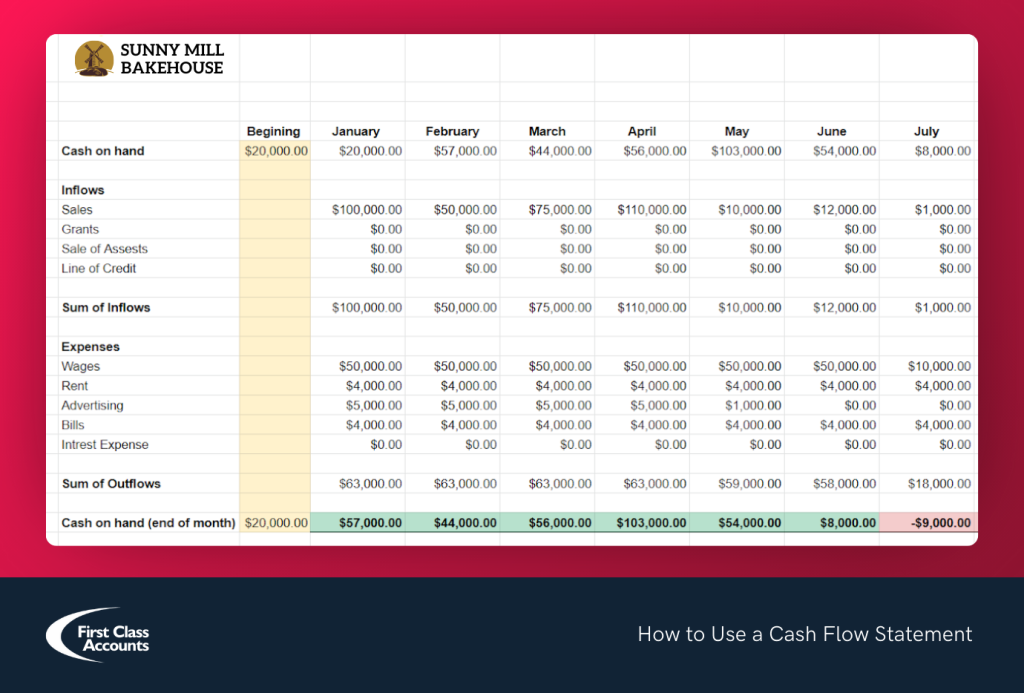Managing your cash well is really important for your business. It’s all about making sure you have enough money to do what you need to do, like paying your team and buying what your business needs.
What’s Cash Flow All About?
Think of cash flow like the blood in your business’s veins. It’s the money coming in and going out.
Keeping a good balance means your business can run smoothly. When you’ve got enough cash, you can think about spending money to help your business grow, like buying a new oven for your bakery or new tools for your garage.
But when money’s tight, you need to be careful about how you spend.
Understanding Cash Flow Statements
To predict how much money your business can expect to have in the future, you’ll need a cash flow statement.
What’s a Cash Flow Statement?
A cash flow statement is a report that shows how much cash is moving in and out of your business. It’s like a diary that keeps track of your money. This statement helps you see where your money comes from and where it goes.
Why a Cash Flow Statement Is Important
- See the Full Picture: A cash flow statement shows you the real story of how your business is doing with money. It’s not just about profit, but also about how cash is moving.
- Make Better Decisions: By looking at a cash flow statement, you can make smarter choices. For example, you’ll know if you can afford new equipment or where you need to cut back on spending.
Key Parts of a Cash Flow Statement
- Cash from Operating Activities: This part shows the cash you get from your everyday business activities, like selling products or services.
- Cash from Investing Activities: This shows money spent on or made from things like buying new equipment or selling an old vehicle.
- Cash from Financing Activities: This includes money from loans you’ve taken or money you’ve paid back.
How to Use a Cash Flow Statement
- Track Regularly: Check your cash flow statement regularly, like every month. This helps you stay on top of your business’s financial health.
- Identify Trends: Look for patterns. Maybe you’re spending too much on something or there’s a season when you make more money.
- Plan for the Future: Use this info to plan ahead. If you know when cash is tight, you can prepare by saving more when times are good.

Getting Help
If you’re not sure how to make or read a cash flow statement, don’t worry. A bookkeeper can help you understand it and use it to make your business stronger. Find a bookkeeper near you to book your free consultation.
Where Does the Money Come From? Cash Flow Sources
Alright, let’s get down to the basics of where your business’s money is actually coming from–the cash flow sources.
1. Operations: The Daily Hustle
This is the money you make from what your business does every day, like selling cakes if you own a bakery or fixing cars if you run a garage. If you’re a plumber, it’s fixing pipes; if you’re in retail, it’s selling your goods.
2. Investments: Money Making Money
When you look at a cash flow statement, there’s a part called ‘Cash Flow from Investing Activities’. It helps you see how your decisions about buying or selling big things are affecting your business’s money.
What Counts as Investing Activities?
- Buying Physical Assets: This could be when you buy something big and important for your business, like a new oven for your bakery or new tools for your garage.
- Investing in or Selling Securities: Sometimes, businesses invest in things like stocks or bonds, or they might sell these investments. This is also part of investing activities.
- Selling Assets: If you sell something big that your business owns, like a company vehicle or old equipment, that’s also included here.
Investing in your business is a big part of growing and improving, but it’s also important to keep track of how these decisions impact your cash flow.
3. Financing Activities: Borrowing or Repaying
Sometimes you might borrow money to help your business or pay back loans you’ve taken. Whether you’re taking a loan to launch a new project or paying back what you borrowed, these activities affect your cash flow too.
If the plumbing jobs are booming, you might think about upgrading your tools. If investments are paying off, maybe it’s time to explore new products. And if you’re in a borrowing phase, you’ll want to make sure it’s all part of the plan to pay it back.
9 Simple Tips to Manage Your Cash Flow
Properly calculating cash flow and making a cash flow forecast is pretty straightforward. Let’s take a look at what you can do to see your cash spent and cash earned in your statement of cash flows.
1. Plan Your Cash
Start by understanding how much money you need to run your business day-to-day and in the future.
In order to manage your cash flows, you first need to break it down. What does it look like?
Consider your:
- Operating Cash Flow: The cash generated from the everyday business activities like selling products or providing services.
- Cash Equivalents: Short-term investments that you can quickly convert into cash, such as money market funds or treasury bills.
- Net Income: The total profit of a business after all expenses and taxes have been deducted from the total revenue.
- Future Cash Flow Projections: Estimates of the amount of cash the business expects to receive and spend in a future period, helping in financial planning and decision-making.
2. Look at Your Cash Needs
Keep an eye on the money coming in and going out. This helps you plan better. Small businesses in Australia should pay close attention to cash inflows and outflows.
This means, closely scrutinising your:
- Accounts receivable
- Operating expenses
- How much cash your company has access to
3. Make a Budget
Creating a comprehensive budget to ensure that cash paid does not exceed your net income. Plan how you’ll spend your money so you don’t overspend.
Your budget should consider all aspects of your operations, from short-term investments to long-term debt.
By outlining your financial commitments and projecting future expenses, you can maintain a healthy cash flow and prevent potential financial strain.
4. Check Your Spending
Regularly look at what you’re spending money on. This helps you cut costs where you can.
This involves scrutinising payments, investments, and non-cash items.
By identifying areas where money is spent and assessing the usefulness of each expenditure, you can streamline costs and improve overall financial efficiency.
5. Save for a Rainy Day
It’s good to have some extra money saved for unexpected expenses with an emergency fund.
This fund is like a money cushion for surprises. Figure out how much cash you might need, considering things like debts and possible expenses.
Having this backup makes sure your business stays strong when unexpected things pop up.
6. Think Ahead About Cash Needs
Try to predict how much money you’ll need in the future. This helps you stay ready for anything like seasonal changes.
7. Regularly Review Your Business
Keep an eye on how your business is doing. This helps you make smart decisions.
Regularly reviewing your business helps you adapt to changes and keep your business on track for long-term success.
It’s about being prepared and knowing what’s working well and what needs improvement.
8. Collect Payments Quickly and Securely
Explore cash balances, income statements, and the net cash your company receives. Most companies implement secure and automated payment systems to ensure timely and reliable cash inflows.
9. Maximise Tax Benefits
Lastly, maximise tax benefits in compliance with Australian tax laws. Track expenses, payments, and non-cash expenses throughout the year.
Leveraging deductions reduces taxable income, providing your small business with a valuable financial advantage.
Organise Your Finances
Navigating cash flow complexities is a significant aspect of business management.
Partnering with a skilled bookkeeper can provide invaluable insights and guidance, helping you make astute financial choices for your business.
Hire a bookkeeper to ensure you’re on top of your cash flow and are making the right financial decisions for your business. Find a bookkeeper near you today.




